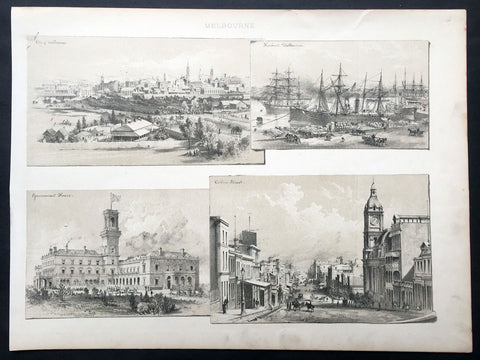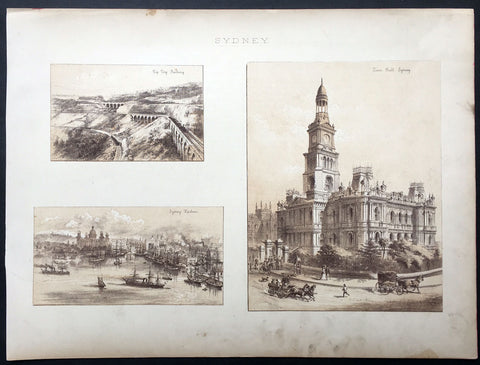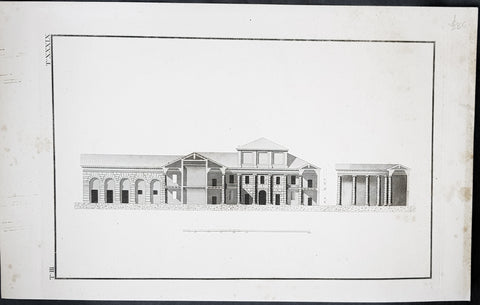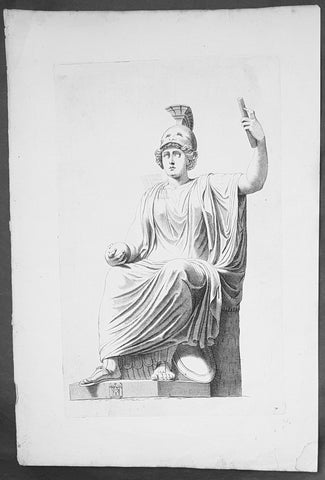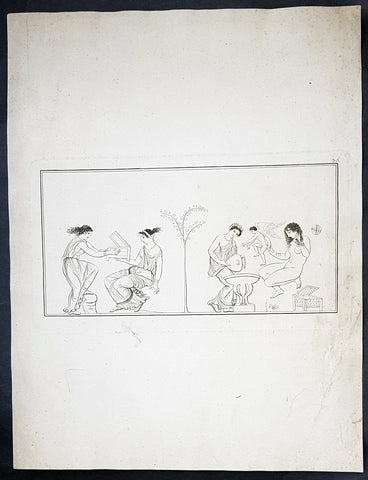Anon
1888 Large Antique Print Views of Melbourne, Australia
- Title : Melbourne
- Date : 1888
- Condition: (A+) Fine Condition
- Ref: 33074
- Size: 14 1/2in x 11in (370mm x 280mm)
Description:
This fine original antique lithograph print four views Melbourne, The City, Harbour, Gov. House & Collins St, was published in ca 1888. (Ref: M&B; Tooley)
General Description:
Paper thickness and quality: - Heavy & stable
Paper color: - White
Age of map color: -
Colors used: -
General color appearance: -
Paper size: - 14 1/2in x 11in (370mm x 280mm)
Plate size: - 14 1/2in x 11in (370mm x 280mm)
Margins: - Min 1/2in (10mm)
Imperfections:
Margins: - Light soiling
Plate area: - None
Verso: - None
1888 Large Antique Print Views of Sydney Australia
- Title : Sydney
- Date : 1888
- Condition: (A+) Fine Condition
- Ref: 33075
- Size: 14 1/2in x 11in (370mm x 280mm)
Description:
This fine original antique lithograph print three views Sydney - The Zig Zag Railway, Sydney Harbour & the Sydney Town Hall - was published in ca 1888. (Ref: M&B; Tooley)
General Description:
Paper thickness and quality: - Heavy & stable
Paper color: - White
Age of map color: -
Colors used: -
General color appearance: -
Paper size: - 14 1/2in x 11in (370mm x 280mm)
Plate size: - 14 1/2in x 11in (370mm x 280mm)
Margins: - Min 1/2in (10mm)
Imperfections:
Margins: - Light soiling
Plate area: - None
Verso: - None
18th Century Antique Copper-Plate Romanesque Architectural Antique Print
- Title : T III............Ta. XXXIX
- Ref : 70542
- Size: 19in x 12in (485mm x 305mm)
- Date : 18th century
- Condition: (A+) Fine Condition
Description:
This large original copper-plate engraved antique cross sectional architectural print, of a substantial Roman building was published in the 18th century.
Beautifully engraved original antique print on heavy laid paper with a heavy impression. (Ref: M&B; Tooley)
General Definitions:
Paper thickness and quality: - Heavy and stable
Paper color : - off white
Age of map color: -
Colors used: -
General color appearance: -
Paper size: - 19in x 12in (485mm x 305mm)
Plate size: - 16in x 10 1/2in (410mm x 270mm)
Margins: - Min 1in (25mm)
Imperfections:
Margins: - Light age toning
Plate area: - None
Verso: - None
18th Century Antique Wood-Block Antique Print Bellona The Roman Goddess of War
- Title : 7
- Date : 18th century
- Condition: (A+) Fine Condition
- Ref: 70525
- Size: 18in x 13 1/2in (460mm x 345mm)
Description:
This original wood-block engraved rare antique print of Bellona The Roman Goddess of War, seated with an Orb and Scroll, was engraved in the mid 18th century.
Beautifully engraved on strong laid paper (no watermark) with a deep impression.
General Definitions:
Paper thickness and quality: - Heavy and stable
Paper color : - off white
Age of map color: -
Colors used: -
General color appearance: -
Paper size: - 19in x 12in (485mm x 305mm)
Plate size: - 16in x 10 1/2in (410mm x 270mm)
Margins: - Min 1in (25mm)
Imperfections:
Margins: - Light age toning
Plate area: - None
Verso: - Old tape reside, not affecting the image
Background:
Bellona was an ancient Roman goddess of war. Her main attribute is the military helmet worn on her head.
Originally named Duellona in the Italic languages, the cult figure who became Bellona was an ancient Sabine goddess of war and identified with Nerio, the consort of the war god Mars - and later with her Greek equivalent Enyo. Her first temple in Rome was dedicated in 296 BCE, where her festival was celebrated on 3rd June. Her priests were known as Bellonarii and used to wound their own arms or legs as a blood sacrifice to her. These rites took place on 24th March, called the day of blood (dies sanguinis), after the ceremony. In consequence of this practice, which approximated to the rites dedicated to Cybele in Asia Minor, both Enyo and Bellona became identified with her Cappadocian aspect, Ma.
The Roman Campus Martius area, in which Bellona’s temple was sited, had extraterritorial status. Ambassadors from foreign states, who were not allowed to enter the city proper, stayed in this complex. The area around the temple of Bellona was considered to symbolise foreign soil, and there the Senate met with ambassadors and received victorious generals prior to their Triumphs. It was here too that Roman Senate meetings relating to foreign war were conducted. Beside the temple was the war column (columna bellica), which represented the boundary of Rome. To declare war on a distant state, a javelin was thrown over the column by one of the priests concerned with diplomacy (fetiales), from Roman territory toward the direction of the enemy land and this symbolical attack was considered the opening of war.
In the military cult of Bellona, she was associated with Virtus, the personification of valour. She then travelled outside Rome with the imperial legions and her temples have been recorded in France, Germany, Britain, and North Africa
18th Century Antique Wood-Block Engraved Antique Print Roman Erotic Art, Pompeii
- Title : 36
- Date : 18th century
- Condition: (A) Very Good Condition
- Ref: 80772
- Size: 18in x 14in (460mm x 355mm)
Description:
This original wood-block engraved rare antique print of erotic Roman art, possibly reliefs from Pompeii, was engraved in the mid 18th century.
Beautifully engraved on strong, heavy, laid paper (no watermark) with a deep impression.
General Definitions:
Paper thickness and quality: - Heavy and stable
Paper color : - off white
Age of map color: -
Colors used: -
General color appearance: -
Paper size: - 18in x 14in (460mm x 355mm)
Plate size: - 12 1/2in x 7in (320mm x 180mm)
Margins: - Min 1in (25mm)
Imperfections:
Margins: - Light soiling
Plate area: - Light soiling
Verso: - Light soiling, several small repairs, no loss
Background:
Sexuality in ancient Rome, and more broadly, sexual attitudes and behaviors in ancient Rome, are indicated by Roman art, literature and inscriptions, and to a lesser extent by archaeological remains such as erotic artifacts and architecture. It has sometimes been assumed that unlimited sexual license was characteristic of ancient Rome; Verstraete and Provençal express the opinion that this perspective was simply a Christian interpretation: The sexuality of the Romans has never had good press in the West ever since the rise of Christianity. In the popular imagination and culture, it is synonymous with sexual license and abuse.
But sexuality was not excluded as a concern of the mos maiorum, the traditional social norms that affected public, private, and military life. Pudor, shame, modesty, was a regulating factor in behavior, as were legal strictures on certain sexual transgressions in both the Republican and Imperial periods. The censors—public officials who determined the social rank of individuals—had the power to remove citizens from the senatorial or equestrian order for sexual misconduct, and on occasion did so. The mid-20th-century sexuality theorist Michel Foucault regarded sex throughout the Greco-Roman world as governed by restraint and the art of managing sexual pleasure.
Roman society was patriarchal (see paterfamilias), and masculinity was premised on a capacity for governing oneself and others of lower status, not only in war and politics, but also in sexual relations. (Virtus), virtus, was an active masculine ideal of self-discipline, related to the Latin word for man, vir. The corresponding ideal for a woman was pudicitia, often translated as chastity or modesty, but a more positive and even competitive personal quality that displayed both her attractiveness and self-control. Roman women of the upper classes were expected to be well educated, strong of character, and active in maintaining their family\'s standing in society. But with extremely few exceptions, surviving Latin literature preserves the voices only of educated male Romans on the subject of sexuality. Visual art was created by those of lower social status and of a greater range of ethnicity, but was tailored to the taste and inclinations of those wealthy enough to afford it, including, in the Imperial era, former slaves.
Some sexual attitudes and behaviors in ancient Roman culture differ markedly from those in later Western societies. Roman religion promoted sexuality as an aspect of prosperity for the state, and individuals might turn to private religious practice or magic for improving their erotic lives or reproductive health. Prostitution was legal, public, and widespread. Pornographic paintings were featured among the art collections in respectable upperclass households. It was considered natural and unremarkable for men to be sexually attracted to teen-aged youths of both sexes, and pederasty was condoned as long as the younger male partner was not a freeborn Roman. Homosexual and heterosexual did not form the primary dichotomy of Roman thinking about sexuality, and no Latin words for these concepts exist. No moral censure was directed at the man who enjoyed sex acts with either women or males of inferior status, as long as his behaviors revealed no weaknesses or excesses, nor infringed on the rights and prerogatives of his masculine peers. While perceived effeminacy was denounced, especially in political rhetoric, sex in moderation with male prostitutes or slaves was not regarded as improper or vitiating to masculinity, if the male citizen took the active and not the receptive role. Hypersexuality, however, was condemned morally and medically in both men and women. Women were held to a stricter moral code, and same-sex relations between women are poorly documented, but the sexuality of women is variously celebrated or reviled throughout Latin literature. In general the Romans had more flexible gender categories than the ancient Greeks.
A late 20th-century paradigm analyzed Roman sexuality in terms of a penetrator–penetrated binary model, a misleadingly rigid analysis that may obscure expressions of sexuality among individual Romans. Even the relevance of the word sexuality to ancient Roman culture has been disputed, but in the absence of any other label for the cultural interpretation of erotic experience, the term continues to be used.

